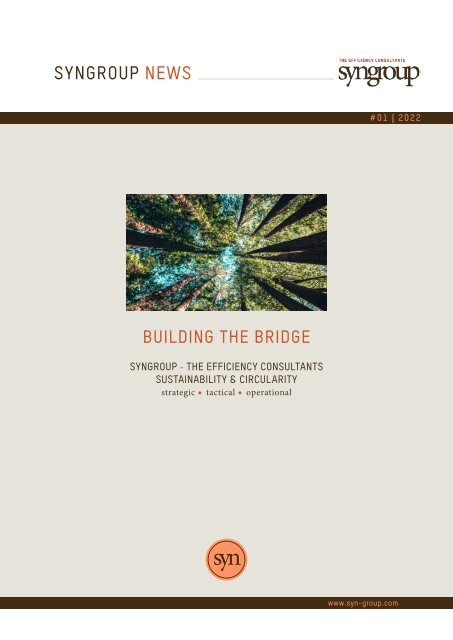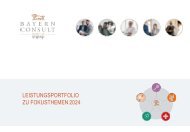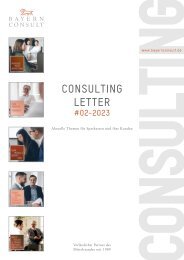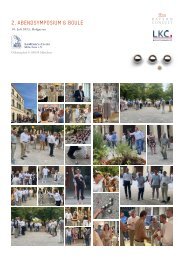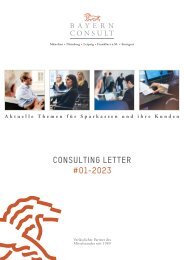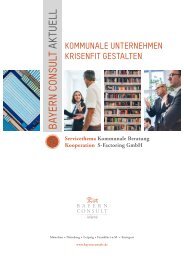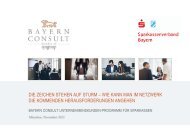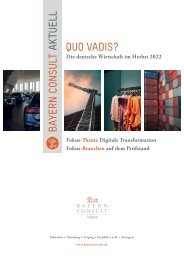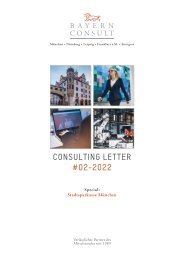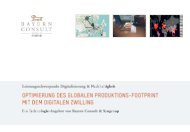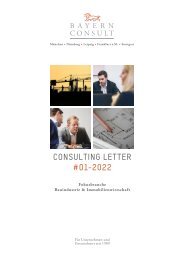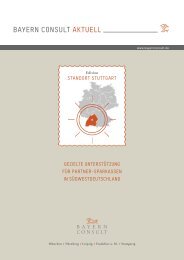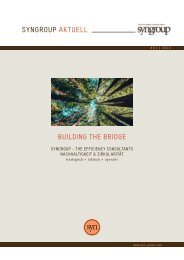Syngroup News #01-2022 Building the Bridge - Sustainability & Circularity in the industrial sector
The manufacturing industry is the world's third-largest source of CO2 emissions. Attention is primarily focused on energy-intensive industries such as basic chemicals, iron and steel production, paper production and processing of stones and earths (construction supply industry). Efforts to reduce energy consumption within the sector are mainly focused on technology improvements or innovations. Syngroup, Austria's largest industry consultant, calls for a broader view. Walter Woitsch, Managing Director Syngroup: "Sustainable production needs optimized processes and must include the downstream sectors. Higher efficiency in processes contributes significantly to reducing the footprint of companies."
The manufacturing industry is the world's third-largest source of CO2 emissions. Attention is primarily focused on energy-intensive industries such as basic chemicals, iron and steel production, paper production and processing of stones and earths (construction supply industry). Efforts to reduce energy consumption within the sector are mainly focused on technology improvements or innovations. Syngroup, Austria's largest industry consultant, calls for a broader view. Walter Woitsch, Managing Director Syngroup: "Sustainable production needs optimized processes and must include the downstream sectors. Higher efficiency in processes contributes significantly to reducing the footprint of companies."
Create successful ePaper yourself
Turn your PDF publications into a flip-book with our unique Google optimized e-Paper software.
<strong>Syngroup</strong> news<br />
<strong>#01</strong> | <strong>2022</strong><br />
<strong>Build<strong>in</strong>g</strong> <strong>the</strong> <strong>Bridge</strong><br />
<strong>Syngroup</strong> - The Efficiency Consultants<br />
<strong>Susta<strong>in</strong>ability</strong> & <strong>Circularity</strong><br />
strategic ◆ tactical ◆ operational<br />
<strong>Syngroup</strong> Aktuell<br />
www.syn-group.com
<strong>Syngroup</strong> NEWS <strong>#01</strong>/<strong>2022</strong><br />
Key Topic <strong>Susta<strong>in</strong>ability</strong> & <strong>Circularity</strong> 1/4<br />
<strong>Build<strong>in</strong>g</strong> The <strong>Bridge</strong><br />
<strong>Syngroup</strong>, <strong>the</strong> Efficiency Consultants - <strong>Susta<strong>in</strong>ability</strong> & <strong>Circularity</strong><br />
The manufactur<strong>in</strong>g <strong>in</strong>dustry is ranked as <strong>the</strong><br />
third largest contributor to CO2 emissions<br />
worldwide, with a share of just under 20%. In<br />
addition, <strong>the</strong>re is a direct l<strong>in</strong>k to <strong>the</strong> two <strong>sector</strong>s<br />
<strong>in</strong> <strong>the</strong> first two places - electricity and<br />
heat generation and, above all, transportation<br />
<strong>in</strong> <strong>the</strong> globalized organization of <strong>in</strong>dustry.<br />
Toge<strong>the</strong>r, <strong>the</strong> three largest <strong>sector</strong>s are responsible<br />
for 86% of CO2 emissions worldwide.<br />
With<strong>in</strong> <strong>in</strong>dustry itself, attention is primarily<br />
focused on energy-<strong>in</strong>tensive <strong>sector</strong>s such as <strong>the</strong><br />
basic chemical <strong>in</strong>dustry, iron and steel production,<br />
paper production and process<strong>in</strong>g of stones<br />
and earths (construction supply <strong>in</strong>dustry). The<br />
focus of efforts to reduce energy consumption<br />
with<strong>in</strong> <strong>the</strong> <strong>sector</strong> today is ma<strong>in</strong>ly on technology<br />
improvements or <strong>in</strong>novations.<br />
» Susta<strong>in</strong>able production needs<br />
optimized processes and must <strong>in</strong>clude<br />
<strong>the</strong> downstream <strong>sector</strong>s.. «<br />
Walter Woitsch<br />
A broader consideration <strong>in</strong> <strong>the</strong> direction of<br />
optimiz<strong>in</strong>g processes and workflows, as well<br />
as an expansion to <strong>the</strong> downstream <strong>sector</strong>s<br />
<strong>in</strong> which <strong>the</strong> products of <strong>the</strong> basic materials<br />
<strong>in</strong>dustry are fur<strong>the</strong>r processed, takes place<br />
only to a limited extent or not at all under <strong>the</strong><br />
aspect of susta<strong>in</strong>ability.<br />
This is exactly where we at <strong>Syngroup</strong> apply<br />
our logic: Higher efficiency <strong>in</strong> <strong>the</strong> processes<br />
contributes significantly to <strong>the</strong> reduction of<br />
<strong>the</strong> Footpr<strong>in</strong>t of <strong>the</strong> companies.<br />
The follow<strong>in</strong>g "10R" illustration uses ten possible<br />
strategies to show <strong>the</strong> path of measures from<br />
conventional production ("l<strong>in</strong>ear economy") to<br />
start<strong>in</strong>g po<strong>in</strong>ts <strong>in</strong> <strong>the</strong> area of <strong>the</strong> circular economy.<br />
This way of look<strong>in</strong>g at th<strong>in</strong>gs succeeds<br />
<strong>in</strong> shift<strong>in</strong>g <strong>the</strong> previous focus of <strong>the</strong> discussion<br />
from - <strong>the</strong> reduction of energy consumption<br />
for production - to be clearly differentiated and<br />
thus expanded.<br />
>>><br />
<strong>Syngroup</strong> <strong>News</strong><br />
www.syn-group.com
<strong>Syngroup</strong> NEWS <strong>#01</strong>/<strong>2022</strong><br />
2/4<br />
The 9R Framework of Circular Approaches<br />
Circular Economy Strategies <strong>in</strong> <strong>the</strong> Production Cha<strong>in</strong> by Priority<br />
Circular Economy<br />
Smarter<br />
Product-<br />
Use and<br />
-Manufacture<br />
R0 Refuse<br />
R1 Reth<strong>in</strong>k<br />
R2 Reduce<br />
+<br />
Make product redundant by abandon<strong>in</strong>g<br />
its function or offer<strong>in</strong>g <strong>the</strong> same function<br />
with a radically different product<br />
Make product use more <strong>in</strong>tensive, e.g.<br />
through shar<strong>in</strong>g products or by putt<strong>in</strong>g<br />
multi-functional products on <strong>the</strong> market<br />
Increase efficiency <strong>in</strong> product<br />
manufacture or use by consum<strong>in</strong>g fewer<br />
natural resources and materials<br />
Extend<br />
lifespan of<br />
product and<br />
its parts<br />
R3 Re-use<br />
R4 Repair<br />
R5 Refurbish<br />
R6 Remanufacture<br />
<strong>in</strong>creas<strong>in</strong>g cirularity<br />
Re-use by ano<strong>the</strong>r consumer of discarded<br />
product which is still <strong>in</strong> good condition<br />
and fulfils <strong>the</strong> orig<strong>in</strong>al function<br />
Repair and ma<strong>in</strong>tenance of defective<br />
product so it can be used<br />
with its orig<strong>in</strong>al function<br />
Restore an old product and<br />
br<strong>in</strong>g it up to date<br />
Use parts of discarded product <strong>in</strong> a<br />
new product with <strong>the</strong> same function<br />
R7 repurpose<br />
Use discarded product or its parts <strong>in</strong> a<br />
new product with a different function<br />
Useful<br />
application<br />
of materials<br />
R8 recycle<br />
R9 recover<br />
Process materials to obta<strong>in</strong> <strong>the</strong> same (high<br />
grade) or lower (low grade)quality<br />
Inc<strong>in</strong>eration of materials<br />
with energy recovery<br />
L<strong>in</strong>ear Economy<br />
Source: Pott<strong>in</strong>g et al. (2017)<br />
The lower <strong>the</strong> consumption of natural resources<br />
and <strong>the</strong> lower <strong>the</strong> environmental impact,<br />
<strong>the</strong> higher <strong>the</strong> degree of circular economy.<br />
>>><br />
<strong>Syngroup</strong> <strong>News</strong><br />
www.syn-group.com
<strong>Syngroup</strong> NEWS <strong>#01</strong>/<strong>2022</strong><br />
Key Topic <strong>Susta<strong>in</strong>ability</strong> & <strong>Circularity</strong> 3/4<br />
1<br />
Strategic Approach<br />
Optimized production footpr<strong>in</strong>ts for <strong>in</strong>dustrial companies<br />
An optimized design of <strong>the</strong> production footpr<strong>in</strong>t<br />
of <strong>in</strong>dustrial companies leads to an<br />
optimization of <strong>the</strong> relevant cost items of up<br />
to 15% - a high proportion of this reduction<br />
also has a direct impact on emissions (e.g.<br />
through <strong>the</strong> reduction of logistics costs).<br />
In almost all cases, <strong>the</strong> production footpr<strong>in</strong>t<br />
of corporate organizations has grown historically.<br />
Production usually follows (short-term)<br />
operational requirements such as specific<br />
competencies at a site, customer or supplier requirements.<br />
Due to <strong>the</strong> progress <strong>in</strong> <strong>the</strong> use of<br />
new analysis tools, today one is able to create<br />
a digital tw<strong>in</strong> of <strong>the</strong> production footpr<strong>in</strong>t quite<br />
quickly. This model can be used to run through<br />
any scenarios for optimiz<strong>in</strong>g <strong>the</strong> current<br />
production landscape. As one customer put it,<br />
"It's <strong>in</strong>credible what a purely technical algorithm<br />
without emotion can deliver <strong>in</strong> terms of<br />
results."<br />
2<br />
Tactical Approach<br />
Adapt production to requirements and optimize processes<br />
Design: an often neglected aspect is "overeng<strong>in</strong>eer<strong>in</strong>g"<br />
with regard to <strong>the</strong> functional<br />
requirements of <strong>the</strong> products. An example<br />
from <strong>the</strong> packag<strong>in</strong>g <strong>in</strong>dustry: <strong>the</strong> specification<br />
(barrier effect) is based on a <strong>the</strong>oretical maximum<br />
requirement - <strong>in</strong> addition, for reasons of<br />
safety, production is carried out at <strong>the</strong> upper<br />
tolerance limit, although technologically "precise"<br />
production would be possible.<br />
Processes: <strong>the</strong> optimized design of <strong>the</strong> processes<br />
/ supply cha<strong>in</strong> before and after <strong>the</strong> actual<br />
production. The <strong>in</strong>ternal sales department<br />
>>><br />
<strong>Syngroup</strong> <strong>News</strong><br />
www.syn-group.com
<strong>Syngroup</strong> NEWS <strong>#01</strong>/<strong>2022</strong><br />
4/4<br />
of <strong>in</strong>dustrial companies offers a very good<br />
projection surface here - many processes are<br />
directly or <strong>in</strong>directly connected with this area<br />
of <strong>the</strong> company.<br />
An example: Problems <strong>in</strong> ma<strong>in</strong>tenance lead to<br />
unplanned downtimes <strong>in</strong> production, changed<br />
production- and delivery schedules cause work<br />
<strong>in</strong> <strong>the</strong> <strong>in</strong>ternal sales department. New delivery<br />
dates have to be negotiated with <strong>the</strong> customer.<br />
But back to <strong>the</strong> <strong>in</strong>side sales department. Our<br />
experience shows that up to one third of <strong>the</strong><br />
time is spent on problem solv<strong>in</strong>g, sometimes<br />
with a direct impact on <strong>the</strong> footpr<strong>in</strong>t. The most<br />
common problem is misproduction, be it due<br />
to wrong specifications or wrong deadl<strong>in</strong>es.<br />
The right use of new technologies can create<br />
improvements. Active <strong>in</strong>tegration of customers<br />
and suppliers <strong>in</strong> <strong>the</strong> supply cha<strong>in</strong> and appropriate<br />
data management <strong>in</strong>crease process reliability<br />
and thus reduce potential sources of error.<br />
3<br />
Operational Approach<br />
Optimiz<strong>in</strong>g overall equipment effectiveness and <strong>in</strong>creas<strong>in</strong>g efficiency<br />
From our po<strong>in</strong>t of view, it is worth tak<strong>in</strong>g a<br />
look at <strong>the</strong> established key figure OEE - Overall<br />
Equipment Effectivenes for overall equipment<br />
effectiveness. In a "typical" European<br />
operation <strong>in</strong> series and process manufactur<strong>in</strong>g,<br />
<strong>the</strong> situation with losses is as follows:<br />
In <strong>the</strong> classic OEE view (proportion of production<br />
time to operat<strong>in</strong>g time), <strong>the</strong> proportion of<br />
defacto production time is just under 50% up<br />
to 85%.<br />
Cause M<strong>in</strong>. Max. Reasons Impact Emissions<br />
Planned downtimes 5% 15% Clean<strong>in</strong>g, setup, ... low<br />
Unplanned dowstimes 3% 12% Incidents<br />
high<br />
Ausschuss, Reparatur<br />
Speed 5% 15%<br />
Non-compliance<br />
with target speed<br />
medium<br />
Scrap 2% 10% Quality, process, ... very high<br />
OEE 48% 85%<br />
This leads directly to two conclusions: Overall<br />
plant effectiveness shows that <strong>the</strong>re is still<br />
sufficient optimization potential even for European<br />
<strong>in</strong>dustrial companies. New tools such<br />
as data-driven <strong>in</strong>formation systems can provide<br />
<strong>the</strong> basis for optimization <strong>in</strong>itiatives. Examples<br />
<strong>in</strong>clude <strong>the</strong> use of sensor technology<br />
and artificial <strong>in</strong>telligence to optimize plant<br />
availability.<br />
<strong>Syngroup</strong> <strong>News</strong><br />
But not to be forgotten - <strong>the</strong> human be<strong>in</strong>g as<br />
an execut<strong>in</strong>g resource rema<strong>in</strong>s at <strong>the</strong> center.<br />
And f<strong>in</strong>ally, <strong>in</strong>creas<strong>in</strong>g efficiency leads directly<br />
to a reduction <strong>in</strong> <strong>the</strong> footpr<strong>in</strong>t of <strong>the</strong> organizations.<br />
In o<strong>the</strong>r words, <strong>in</strong> addition to o<strong>the</strong>r<br />
measures such as fur<strong>the</strong>r technological development,<br />
<strong>in</strong>creas<strong>in</strong>g efficiency makes a significant<br />
contribution to reduc<strong>in</strong>g emissions.<br />
www.syn-group.com
<strong>Syngroup</strong> NEWS <strong>#01</strong>/<strong>2022</strong><br />
Key Topic <strong>Susta<strong>in</strong>ability</strong> & <strong>Circularity</strong><br />
Production Footpr<strong>in</strong>t Optimization<br />
A <strong>Syngroup</strong> Technology-Offer<strong>in</strong>g<br />
Production Footpr<strong>in</strong>t Optimization comb<strong>in</strong>es<br />
data process<strong>in</strong>g and ma<strong>the</strong>matical modell<strong>in</strong>g<br />
methods to: optimally allocate production<br />
sites, evaluate related risk and ensure strategic<br />
<strong>in</strong>vestment <strong>in</strong>itiatives.<br />
◆◆◆<br />
Usually, sizable <strong>in</strong>vestments are validated<br />
us<strong>in</strong>g ROI models, best and worst case<br />
scenario calculations and o<strong>the</strong>r well-known<br />
methods. These calculations are highly focused<br />
on <strong>the</strong> <strong>in</strong>vestment subject and often fail to<br />
address <strong>the</strong> impact on <strong>the</strong> footpr<strong>in</strong>t as a whole<br />
due to <strong>the</strong> huge amount of data and overwhelm<strong>in</strong>g<br />
complexity <strong>in</strong>volved. Production Footpr<strong>in</strong>t<br />
Optimization applies state-of-<strong>the</strong>-art<br />
operations research methods to conquer <strong>the</strong><br />
complexity and enables deci-sion makers to<br />
quickly evaluate different allocation and cost<br />
scenarios <strong>in</strong> a holistic manner.<br />
<strong>Syngroup</strong> <strong>News</strong><br />
Historic Footpr<strong>in</strong>t<br />
optimal Footpr<strong>in</strong>t<br />
How It Works<br />
1<br />
Re-creation of actual production footpr<strong>in</strong>t<br />
based on past logistic flows to customers<br />
and between production sites (Intercompany),<br />
geographic locations and production<br />
capabilities and capa-cities, as well as fixed<br />
and proportional costs of: material, labour,<br />
mach<strong>in</strong>es and logistics.<br />
2<br />
Def<strong>in</strong>ition of scenarios are based upon<br />
<strong>the</strong> actual footpr<strong>in</strong>t, <strong>in</strong>clud<strong>in</strong>g but not<br />
limited to, changes <strong>in</strong> cost-structure,<br />
open<strong>in</strong>g or clos<strong>in</strong>g of production sites<br />
and <strong>the</strong> enter<strong>in</strong>g <strong>in</strong>to new markets<br />
(geography, product).<br />
3<br />
Analytical and visual <strong>in</strong>vestigation of<br />
optimised scenarios and comparisons<br />
to referenced foot-pr<strong>in</strong>ts, by look<strong>in</strong>g at:<br />
capacity utilisation, redirection of logistic<br />
flows and high yield footpr<strong>in</strong>t modifications<br />
(based upon cost reductions).<br />
www.syn-group.com
<strong>Syngroup</strong> NEWS <strong>#01</strong>/<strong>2022</strong><br />
Case Study<br />
Production Footpr<strong>in</strong>t Optimization<br />
1<br />
Service<br />
Digital Transformation<br />
Industry<br />
Plastics<br />
2BackgrounD<br />
Our client is a global plastics processor<br />
undergo<strong>in</strong>g a consolidation process<br />
and is evaluat<strong>in</strong>g its organically grown<br />
and fragmented presence.<br />
3 4<br />
Approach<br />
Primarily, <strong>the</strong> Footpr<strong>in</strong>t is to be designed<br />
<strong>in</strong> such a way that cost advantages<br />
arise <strong>in</strong> <strong>the</strong> medium term and low risks<br />
<strong>in</strong> <strong>the</strong> long term <strong>in</strong> <strong>the</strong> event of cost and<br />
market uncerta<strong>in</strong>ties. An "unemotional"<br />
evaluation based on facts, figures<br />
and ma<strong>the</strong>matics should serve as a basis<br />
for decision-mak<strong>in</strong>g.<br />
Typical Project TAsks<br />
Analyse von Footpr<strong>in</strong>t, Prozessen,<br />
Produkten und Kunden.<br />
Datensammlung & Konfiguration<br />
des Optimierungsmodells.<br />
Neuberechnung des Footpr<strong>in</strong>ts<br />
zur Validierung<br />
The collected data was fed <strong>in</strong>to <strong>the</strong> optimization<br />
model, <strong>the</strong> actual footpr<strong>in</strong>t<br />
was replicated and reasonable scenarios<br />
were derived (e.g. new plants, market<br />
growth, shifts <strong>in</strong> <strong>the</strong> cost structure).<br />
Visualization of <strong>the</strong> optimized scenarios<br />
and enrichment with <strong>in</strong>teractive<br />
features allows to navigate through <strong>the</strong><br />
results and draw conclusions.<br />
In a next step, <strong>the</strong> model was fur<strong>the</strong>r developed<br />
with more <strong>in</strong>dustry- and<br />
customer-specific scenarios. Now it frequently<br />
supports global and local projects<br />
that have an impact on production<br />
distribution, <strong>in</strong>vestments or logistics.<br />
<strong>Syngroup</strong> <strong>News</strong><br />
Def<strong>in</strong>ition von Szenarien als<br />
Entscheidungsgrundlage.<br />
Konsolidierung der Szenarien<br />
und Ableitung umsetzbarer<br />
Erkenntnisse.<br />
Result<br />
10% Cost reduction<br />
of footpr<strong>in</strong>t<br />
on global scale<br />
www.syn-group.com
<strong>Syngroup</strong> <strong>News</strong><br />
<strong>#01</strong>/<strong>2022</strong><br />
Vienna ◆ Munich ◆ Cranfield ◆ Milan ◆ Denver<br />
<strong>Syngroup</strong> MANAGEMENT CONSULTING GMBH<br />
E: office@syn-group.com<br />
www.syn-group.com<br />
<strong>Syngroup</strong> Management Consult<strong>in</strong>g GmbH, © <strong>2022</strong> | Photos: Amelie Chapala<strong>in</strong>, pixabay, unsplash


